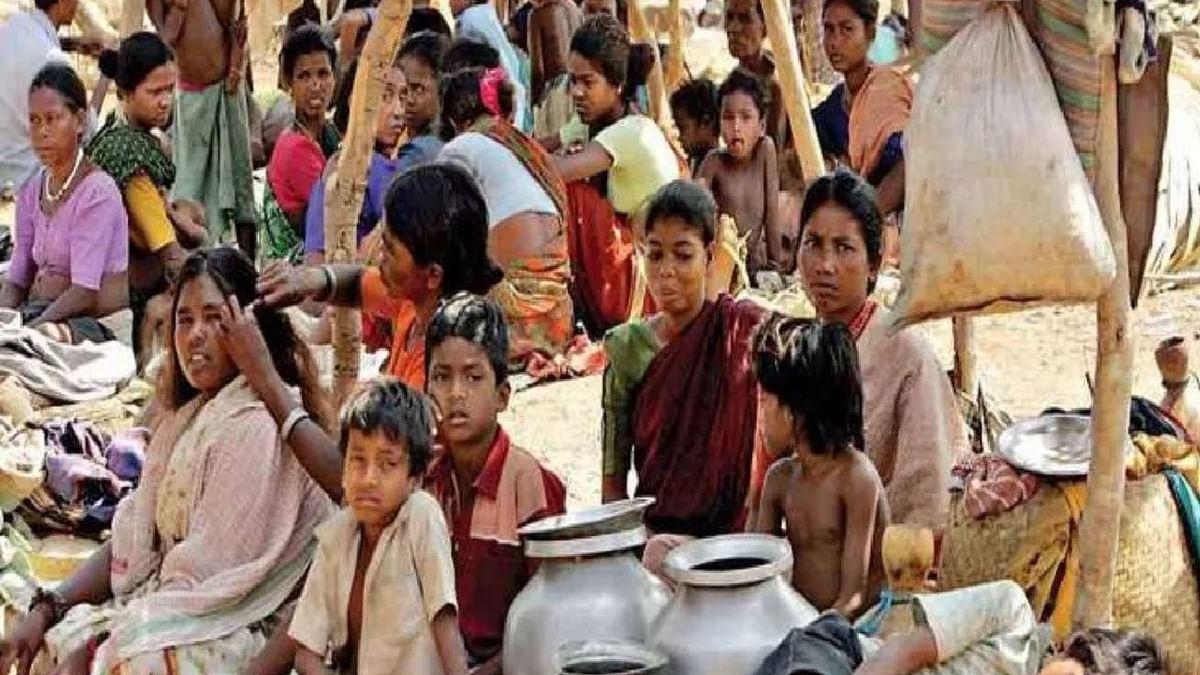Lucknow : In Uttar Pradesh, 3.43 crore people have come out of the grip of multidimensional poverty in the period from the financial year 2015-16 to 2019-21. In the state, 37.68% people were in poverty, while in 2019-21 their number decreased to 22.93%. Poverty has reduced more rapidly in rural areas than in urban areas. In the rural areas of the state, where 44.29% people were in the scope of multidimensional poverty in 2015-16, their number decreased to 26.35% in 2019-21. Whereas in 2015-16, 17.72% people in urban areas were caught in the clutches of poverty, whose number has come down to 11.57% in 2019-21.
NITI Aayog released the figures on Monday
These facts have been revealed in the National Multidimensional Poverty Index report released by NITI Aayog on Monday. This index is based on a total of 12 parameters related to health, education and standard of living. It is believed that the poor welfare schemes of the central and state governments have a big role in reducing multidimensional poverty.
More reduction in multidimensional poverty in backward districts
Compared to developed districts, there has been more reduction in multidimensional poverty in backward districts. During this period, maximum 29.64% of the people who came out of the multidimensional poverty in the state are from Maharajganj. Gonda is second and Balrampur is third. The lowest decrease of 3.01 percent has come in Gautam Buddha Nagar. In this context, a decrease of 3.68% has been recorded in Lucknow.
-
Maharajganj – 29.64
-
Gonda – 29.55
-
Balrampur – 27.90
-
Kaushambi – 25.75
-
Cucumber -25.23
-
Shravasti – 24.42
-
Jaunpur – 24.65
-
Basti – 23.36
-
Ghazipur-22.83
-
Kushinagar – 22.28
-
Chitrakoot – 21.40
According to a report released by NITI Aayog, around 135 million people in India moved out of multidimensional poverty between 2015-16 and 2019-21, with the sharpest reduction seen in Uttar Pradesh, followed by Bihar, MP, Odisha and Rajasthan. is the location. According to the report, a significant decline of 9.89 percentage points was registered in the number of multidimensional poor in the country, which has increased from 24.8% in 2015-16 to 14.9% in 2019-2021.
At the same time, the fastest decline in poverty in rural areas decreased from 32.5% to 19.3%. Urban areas saw a decrease from 8.7% to 5.3% in the same period. Uttar Pradesh recorded the highest reduction in the number of poor and 3.43 crore people came out of multidimensional poverty. The report provides multidimensional poverty estimates for 36 states and union territories and 707 districts. The broad methodology adopted is in line with global practices.
Between 2015-16 and 2019-21, the MPI value has nearly halved from 0.117 to 0.066 and poverty intensity has declined from 47% to 44%, helping India achieve SDG target 1.2 (reduce multiple poverty). is on its way to do. Dimensional poverty is at least halved, well ahead of the 2030 deadline. According to an official statement, “It reflects the government’s strategic focus on ensuring sustainable and equitable growth and eradicating poverty by 2030, thereby adhering to its commitment to the Sustainable Development Goals (SDGs).
The national Multidimensional Poverty Index (MPI) measures deprivations in health, education and living standards represented by 12 SDG-aligned indicators. These include nutrition, child and adolescent mortality, maternal health, years of schooling, school attendance, cooking fuel, sanitation, drinking water, electricity, housing, assets and bank accounts. As per the report, significant improvement has been observed in all the 12 indicators.
NITI Aayog Vice Chairman Suman Berry said that I am happy to note that between NFHS (National Family Health Survey)-4 and NFHS-5, all the states and union territories have made commendable progress. India’s multi-sectoral approach in addressing poverty is evident in the reduction in the number of multi-dimensional poor people by almost half, a reduction of 14.96%, and the improved MPI score in this edition.
He further said that the Centre’s focus on improving access to sanitation, nutrition, cooking fuel, financial inclusion, drinking water and electricity has led to significant progress in these areas. All 12 parameters of MPI have shown improvement. Major schemes like POSHAN Abhiyaan and Anemia Mukt Bharat have contributed in reducing the gaps in health.
Initiatives such as the Swachh Bharat Mission (SBM) and Jal Jeevan Mission (JJM) have improved sanitation across the country. The impact of these efforts is evident in the improvement of 21.8 percentage points in sanitation deficit. The provision of subsidized cooking fuel through the Pradhan Mantri Ujjwala Yojana (PMUY) has brought about a positive change in lives with an improvement in cooking fuel shortage by 14.6 percentage points.
According to the report, schemes like Saubhagya, Pradhan Mantri Awas Yojana (PMAY), Pradhan Mantri Jan Dhan Yojana (PMJDY) and Samagra Shiksha have also played an important role in reducing multidimensional poverty in the country. The remarkable progress achieved through extremely low deprivation rates, especially in terms of access to electricity, bank accounts and drinking water, reflects the government’s unwavering commitment to improving the lives of citizens and creating a brighter future for all. depicts. Consistent implementation of a diverse set of programs and initiatives with strong inter-linkages has led to a significant reduction in deprivation across multiple indicators, the official statement said.
Shoko Noda, Resident Representative, UNDP India, said the national MPI report underlines the remarkable progress made by India in nearly halving multidimensional poverty between 2015-2016 and 2019-2021, which reflects the country’s unwavering commitment to achieving the SDGs. It highlights the commitment and its steadfast efforts. Eliminate poverty and improve the lives of your citizens. In his message on the report, Noda said it is commendable that India’s rural areas and its poorest states have seen the sharpest declines.

